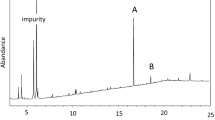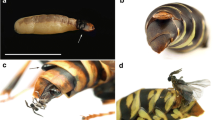Abstract
(E,E)- and (E,Z)-8,10-Dodecadien-1-ol acetates were identified in a 1∶4.3 ratio in the extract of abdominal tips of female filbert-worm moths,Melissopus latiferreanus (Walsingham). The identifications were based on electroantennogram (EAG) analysis, gas chromatography, mass spectrometry, ozonolysis, and synthesis. TheE,Z isomer produced the stronger EAG response. In the field tests of various ratios ofE,E∶E,Z, the ratio found in the extract captured the most males. The pureE,E isomer initially was not attractive by itself (<0.1%E,Z) but became attractive after a few days, presumably because of isomerization. TheE, Z isomer (<0.1%E,E) was attractive initially, but this compound might have isomerized faster than theE,E isomer. A study of the isomerization showed that regardless of the initial mixture of 8,10-dodecadien-1-ol acetate isomers, almost complete equilibration existed after one month. The equilibrium mixture consisted of 9%Z8,E10, 65%E8,E10, 23%E8,Z10, and 3%Z8,Z10. Concentrations in rubber septa (1∶4 ratio ofE,E toE,Z) of 0.03–3.0 mg/septum produced equivalent trap catches.
Similar content being viewed by others
References
Beroza, M., andBiesl, B.A. 1967. Rapid determination of olefin position in organic compounds in microgram range by ozonolysis and gas chrmatography.Anal. Chem. 39:1131–1135.
Butler, L.I., andMcDonough, L.M. 1979. Insect sex pheromones; evaporation rate of acetates from natural rubber septa.J. Chem. Ecol. 5:825–837.
Davis, H.G., andMcdonough, L.M. 1981. Sex attractant for the filbertworm,Melissopus latiferranus (Walsingham).Environ. Entomol. 10:390–391.
Davis, H.G., McDonough, L.M., andRichardson, G. 1983. Sex attractant of the filbertworm moth: tests in pomegranate orchards.Southwest. Entomol. 8:137–139.
Frerot, B., Priesner, E., andGallois, M. 1979. A sex attractant for the green budworm moth,Heyda nubiferana.Z. Naturforsch 34C:1248–1252.
Fijiwara, H., Sato, Y., andNishi, K. 1976. Physico-chemical studies on the sex pheromones of insects. I. Behavior of the sex pheromone ofSpodoptera litura F. in rubber caps.J. Takeda Res. Lab. 35:52–59.
Greenway, A.R., andWall, C. 1981. Attractant lures for males of the pea moth,Cydia nigricana (F.) containing (E)-10-dodecen-1-yl acetate and (E,E)-8,10-dodecadien-1-yl acetate.J. Chem. Ecol. 7:563–573.
Hathaway, D.O., McDonough, L.M., George, D.A., andMoffitt, H.R. 1979. Antipheromone of the codling moth,Laspeyresia pomonella (L.): Potential for control by air permeation.Environ. Entomol. 8:318–321.
Hill, A.S., Berisford, C.W., Brady, U.E., andRoelofs, W.L. 1976. Sex pheromone of the pitch pine tip moth,Rhyacionia rigidana. Environ. Entomol. 5:959–960.
Ideses, R., Shani, A., andKlug, J.T. 1982. Sex pheromone of European grapevine moth (Lobesia botrana); its chemical transformation in sunlight and heat.J. Chem. Ecol. 8:983–980.
McDonough, L.M., Kamm, J.A., andBierl-Leonhardt, B.A. 1980. Sex pheromone of the armyworm,Pseudaletia unipuncta (Haworth) (Lepidoptera: Noctuidae).J. Chem. Ecol. 6:565–572.
McDonough, L.M., Huffman, M.P., Bierl-Leonhardt, B.A., Smithhisler, C.L., Bailey, J.B., andDavis, H.G. 1982. Sex pheromone of the avocado pest,Amorbia cuneana(Walsingham) (Lepidoptera: Tortricidae): Structure and synthesis.J. Chem. Ecol. 8:255–265.
Roelofs, W.L. 1978. Threshold hypothesis for pheromone perception.J. Chem. Ecol. 4:685–699.
Roelofs, W.L., andCardé, R.T. 1974. Sex pheromones in the reproductive isolation of lepidopterous species, pp. 96–114,in M.C. Birch (ed.). Pheromones. American Elsevier, New York.
Roelofs, W.L., Bartell, R.J., Hill, A.S., Cardé, R.T., andWaters, L.H. 1972. Codling moth sex attractant-field trials with geometrical isomers.J. Econ. Entomol. 65:1276–1277.
Shani, A., andKlug, J.T. 1980. Sex pheromone of Egyptian cotton leafworm (Spodoptera littoralis); its chemical transformation under field conditions.J. Chem. Ecol. 6:875–881.
Wall, C., Greenway, A.R., andBurt, P.E. 1976. Electroantennographic and field responses of the pea moth,Cydia nigricana, to sex attractants and related compounds.Physiol. Entomol. 1:151–157.
Author information
Authors and Affiliations
Additional information
This paper reports the results of research only. Mention of a commercial product in this paper does not constitute a recommendation by the U.S. Department of Agriculture.
Rights and permissions
About this article
Cite this article
Davis, H.G., McDonough, L.M., Burditt, A.K. et al. Filbertworm sex pheromone. J Chem Ecol 10, 53–61 (1984). https://doi.org/10.1007/BF00987643
Received:
Revised:
Issue Date:
DOI: https://doi.org/10.1007/BF00987643




